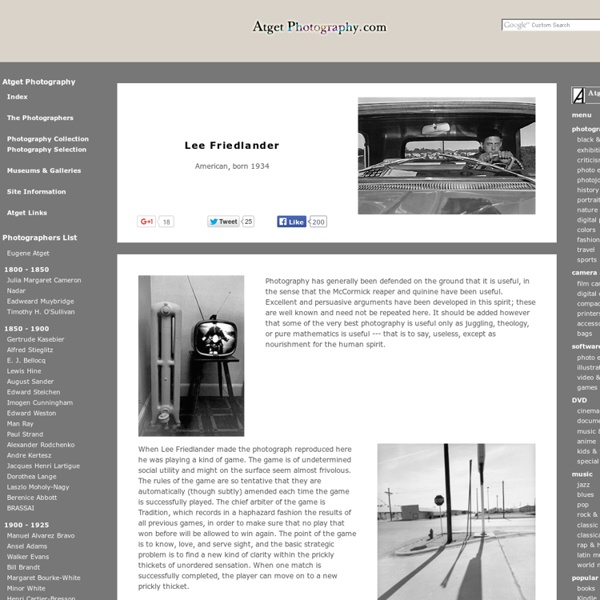Lee Friedlander / Biography & Images - Atget Photography.com / Videos Books & Quotes

BRUCE MILPIED | photographe
Jared Platt Blog — Jared Platt's Photography Blog
ANDRE KERTESZ
Perhaps more than any other photographer, Andre Kertesz discovered and demonstrated the special aesthetic of the small camera. These beautiful little machines seemed at first hardly serious enough for the typical professional, with his straightforward and factual approach to the subject. Most of those who did use small cameras tried to make them do what the big camera did better; deliberate, analytical description. Kertesz had never been much interested in deliberate, analytical description; since he had begun photographing in 1912 he had sought the revolution of the elliptical view, the unexpected detail, the ephemeral moment ___ not the epic but the lyric truth. When the first 35mm camera ___ the Leica ___ was marketed in 1925, it seemed to Kertesz that it had been designed for his own eye. Like his fellow Hungarian Moholy-Nagy, he loved the play between pattern and deep space; the picture plane of his photographs is like a visual trampoline, taut and resilient. " by John Szarkowski
Cdanslaboite | Cdanslaboite à Bordeaux association photographique d'intérêt général
Recent Work by Jay Maisel
1 2 3 4 6 7 8 9 10 11 12 13 14 15 16 18 19 21 22 24 25 26 27 28 29 30 31 33 34 35 36 37 38 39 40 Grid View Previous Next
IDRIS KHAN
Home > Artists A–Z > Idris Khan > Artworks for Sale Idris Khan (British, 1978) artnet—The Art World Online. ©2014 Artnet Worldwide Corporation. All rights reserved. artnet® is a registered trademark of Artnet Worldwide Corporation, New York, NY, USA.
Arles 5 : découvertes | lunettesrouges1
Pauline Fargue, Nul Jour, Prix Découverte, vue d’exposition C’est l’autre pôle des Rencontres, indispensable, celui qui permet de découvrir des inconnus, dans les expos officielles comme dans le Off. Mais, cette année, l’exposition officielle pour le Prix Découverte est un peu décevante : si on excepte un assez drôle pied de nez pileux et une mise en scène originale, mais d’une dénonciation assez banale, beaucoup des nominés ne frappaient pas par leur originalité. J’en avais toutefois retenu trois : la Française Pauline Fargue qui joue sur les échelles et expose de très élégants petits carnets intimes croisant texte et photos (et c’est elle qui obtint le prix), le Singapourien Robert Zhao Renhui, qui, dans un style évoquant un peu Taryn Simon, montre des altérations (réelles ou inventées) de la nature, poissons fluorescents ou singe qui parle, et le Sénégalais Omar Victor Diop, pour qui j’avais finalement voté. Omar Victor Diop, Juan de Pareja (1606-1670) Lore Stessel J'aime :
Jim Brandenburg
WALKER EVANS
The abstract visual games that had entranced and delighted most adventurous photographers during the decade of the twenties had lost much of their charm by the early thirties. Our fondness for historical symmetry makes it tempting to ascribe the change to the problems of the period and to a heightened awareness among artists of social and political priorities. Unfortunately this explanation, neat as it is, does not quite fit the facts, which seem to demonstrate no dependable correlation between realism and social commitment, or between abstraction and social indifference. Moholy-Nagy, deeply committed to the social utility of art, was a formalist; Brassai, the ultimate realist, seems totally immersed in the specifics of life, and scarcely aware of society. It seems likely that the change that occurred in photography around 1930 was fundamentally a matter of formal evolution --- the result of what had gone before in photography. from "Looking at Photographs " by John Szarkowski Stare.
Related:



